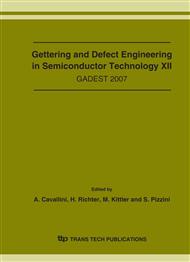[1]
J. Margil, J. Stoemenos, C. Jaussaud, M. Bruel, Appl. Phys. Lett. 54 (1989) 526.
Google Scholar
[2]
D. Venables, K.S. Jones, F. Navamar, Appl. Phys. Lett. 60 (1992) 3147.
Google Scholar
[3]
D.S. Zhou, O.W. Holland, D.J. Budai, Appl. Phys. Lett. 63 (1993) 3580.
Google Scholar
[4]
O.W. Holland, D.S. Zhou, D.K. Thomas, Appl. Phys. Lett. 63 (1993) 896.
Google Scholar
[5]
O.W. Holland, D. Fathy, D.K. Sadana, Appl. Phys. Lett. 69 (1996) 674.
Google Scholar
[6]
O.W. Holland, D.K. Sadana, US patent: US 6 259 137 B1.
Google Scholar
[7]
S. Nakashima, T. Katayama, Y. Miyamura, A. Matsuzaki, M. Kataoka,D. Ebi, M. Imai, K. Izumi, N. Ohwada, J. Electrochem. Soc. 143, (1996) 244.
DOI: 10.1149/1.1836416
Google Scholar
[8]
U. Gösele, E. Schroer, J. -Y. Huh, Appl. Phys. Lett. 67 (1995) 241.
Google Scholar
[9]
A. Matsumura, I. Hamaguchi, K. Kawamura, T. Sasaki, S. Takayama, Y. Nagatake, Microelectronic Engineering 66(2003) 400.
DOI: 10.1016/s0167-9317(02)00913-9
Google Scholar
[10]
V. Raineri, S.U. Campisano, Appl. Phys. Lett. 66 (1995) 3654.
Google Scholar
[11]
M. Chen, J. Chen, W. Zheng, L. Li, H.C. Mu, Z.X. Lin, Y.H. Yu, X. Wang, G.Y. Wang, J. Vac. Sci. Technol. B 19 (2001) 337.
Google Scholar
[12]
M. Chen, X. Wang, J. Chen, Y. Dong, W. Yi, X. Liu, Xi Wang, J. Vac. Sci. Technol. B 21 (2003) (2001).
Google Scholar
[13]
M. Chen, X. Wang, J. Chen, Y. Dong, X. Liu, Y. Yu, Xi Wang, Appl. Phys. Lett. 80 (2002) 880.
Google Scholar
[14]
A. Ogura and H. Ono, Appl. Surf. Sci. 159-160 (2000) 104.
Google Scholar
[15]
R. Kögler, A. Mücklich, H. Reuther, D. Krecar, H. Hutter, W. Skorupa, Solid State Phenomena 108-109 (2005) 321.
DOI: 10.4028/www.scientific.net/ssp.108-109.321
Google Scholar
[16]
O.W. Holland, L. Xie, B. Nielsen, D.S. Zhou, J. Electr. Mat. 25 (1996) 99.
Google Scholar
[17]
O.W. Holland, D.K. Thomas, D.S. Zhou, Appl. Phys. Lett. 66 (1995) 1892.
Google Scholar
[18]
J. Biersack and L.G. Haggmark: Nucl. Instrum. and Meth, B 174, (1980) 257.
Google Scholar
[19]
R. Kögler, A. Peeva, J. Kaschny, w. Skorupa, H. Hutter, Nucl. Instrum. and Meth. B 186 (2002) 298.
Google Scholar
[20]
A. Peeva, R. Kögler, W. Skorupa, J.S. Christensen, A. Yu. Kuznetsov, J. Appl. Phys. 95 (2004) 4738.
Google Scholar
[21]
J.S. Williams, M.J. Conway, J. Wong-Leung, P.N.K. Deenapanray, M. Petravic, R.A. Brown, D.J. Eaglesham, D.C. Jacobson, Appl. Phys. Lett. 75 (1999) 2424.
DOI: 10.1063/1.125035
Google Scholar
[22]
G. Brauer, W. Anwand, W. Skorupa, A.G. Revesz, J. Kuriplach, Phys. Rev. B 66 (2002) 195331.
Google Scholar


